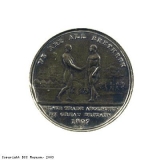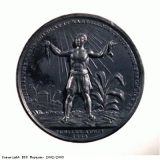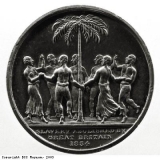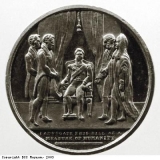Commemorative medallions
Commemorative medallions were hugely popular in the 19th century as collector’s items. Medallions, or coins, were issued to commemorate almost any event, from a royal marriage to the opening of a bridge or the anniversary of the death of a slightly famous person.
Commemorative medallions were issued in 1807, 1834 and 1838 to mark, respectively, the ending of the slave trade, the ending of slavery and the actual freeing of the slaves from slavery within the British territories. Several medallions were issued in 1807 and 1834 to mark the passing of the slave trade and of slavery. Yet only one seems to have been issued in 1838 to mark the date when slaves were actually freed from slavery. Perhaps everyone thought that it happened in 1834, and they missed the important fact that slaves were not really free? Slaves were in fact apprenticed to their old masters for several years so that they could ‘learn’ how to deal with freedom when it came in 1838.
These medallions commemorate the end of slavery but they do not explore the contribution that slaves made to British prosperity. Instead, they celebrate the achievements of white liberal public opinion in achieving freedom for the slaves. They imply that slaves themselves played only a passive role in their own liberation. In actual fact, the opposite was true. By their actions, both at work and in rebellion , slaves had shown that slavery could not work anymore. By 1834, plantation owners were happy to make the switch from slave labour to wage labour, having been paid compensation for the loss of their slaves by the British government.






